Positive Behaviour Management Plan in Schools
VerifiedAdded on 2021/06/17
|17
|3729
|472
AI Summary
Positive Behaviour Management Plan in Schools1 Positive Behaviour Management Plan in Schools 18 Positive Behaviour Management Plan in Schools by Course: Tutor: University: Department: Date: PART ONE 3 1.1 My Philosophy of Teaching in relation to Classroom Management 3 PART TWO 5 2.1 Skinner’s Theory of behavioral modification 5 2.2 Significant Differences between Skinner’s Behaviourism theory and others 7 PART THREE 9 3.1 Classroom Behaviour Management Plan 9 PART FOUR 14 4.1 Re-designed Format 14 References 15 PART ONE 1.1 My Philosophy of Teaching in
Contribute Materials
Your contribution can guide someone’s learning journey. Share your
documents today.
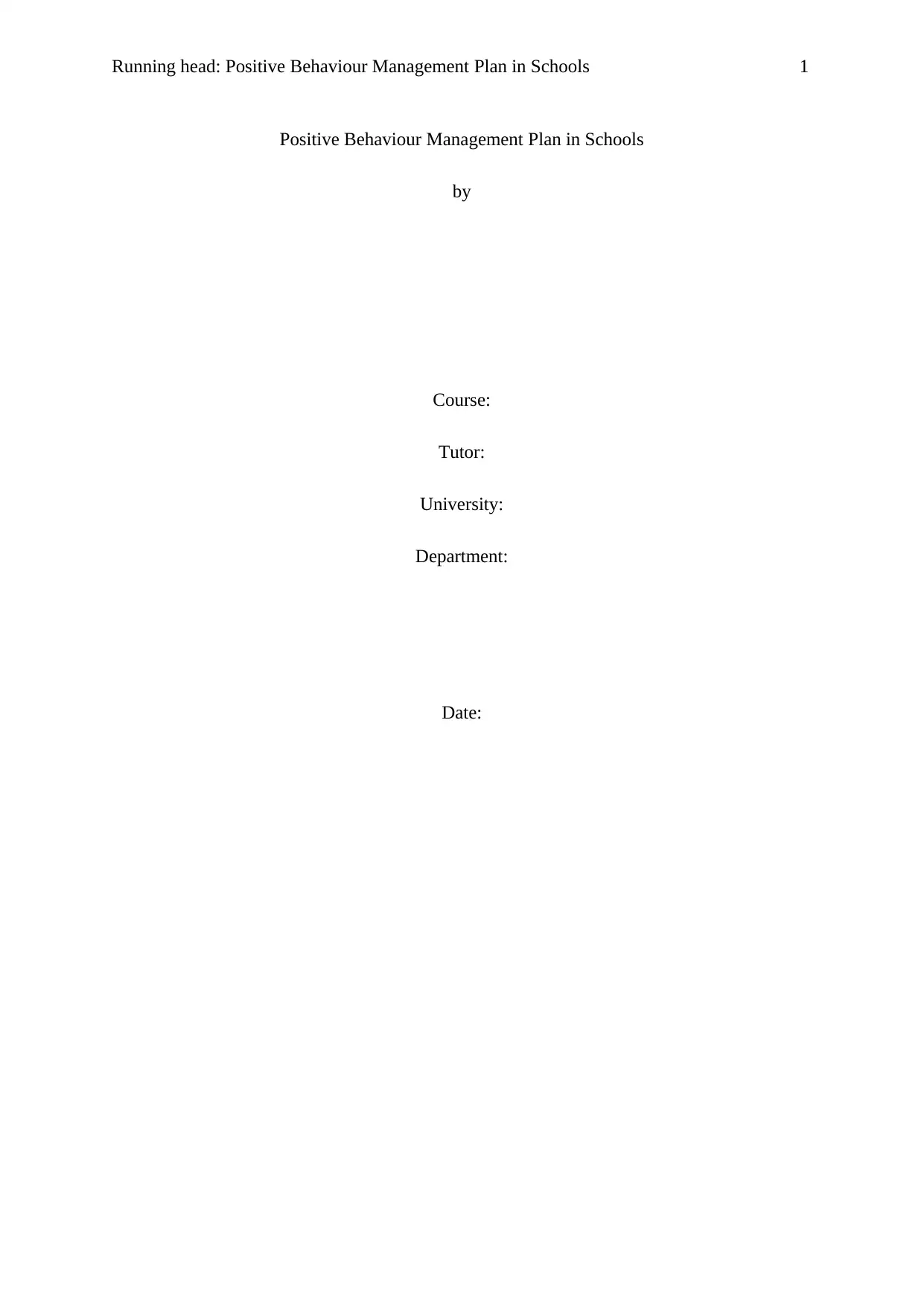
Running head: Positive Behaviour Management Plan in Schools 1
Positive Behaviour Management Plan in Schools
by
Course:
Tutor:
University:
Department:
Date:
Positive Behaviour Management Plan in Schools
by
Course:
Tutor:
University:
Department:
Date:
Secure Best Marks with AI Grader
Need help grading? Try our AI Grader for instant feedback on your assignments.
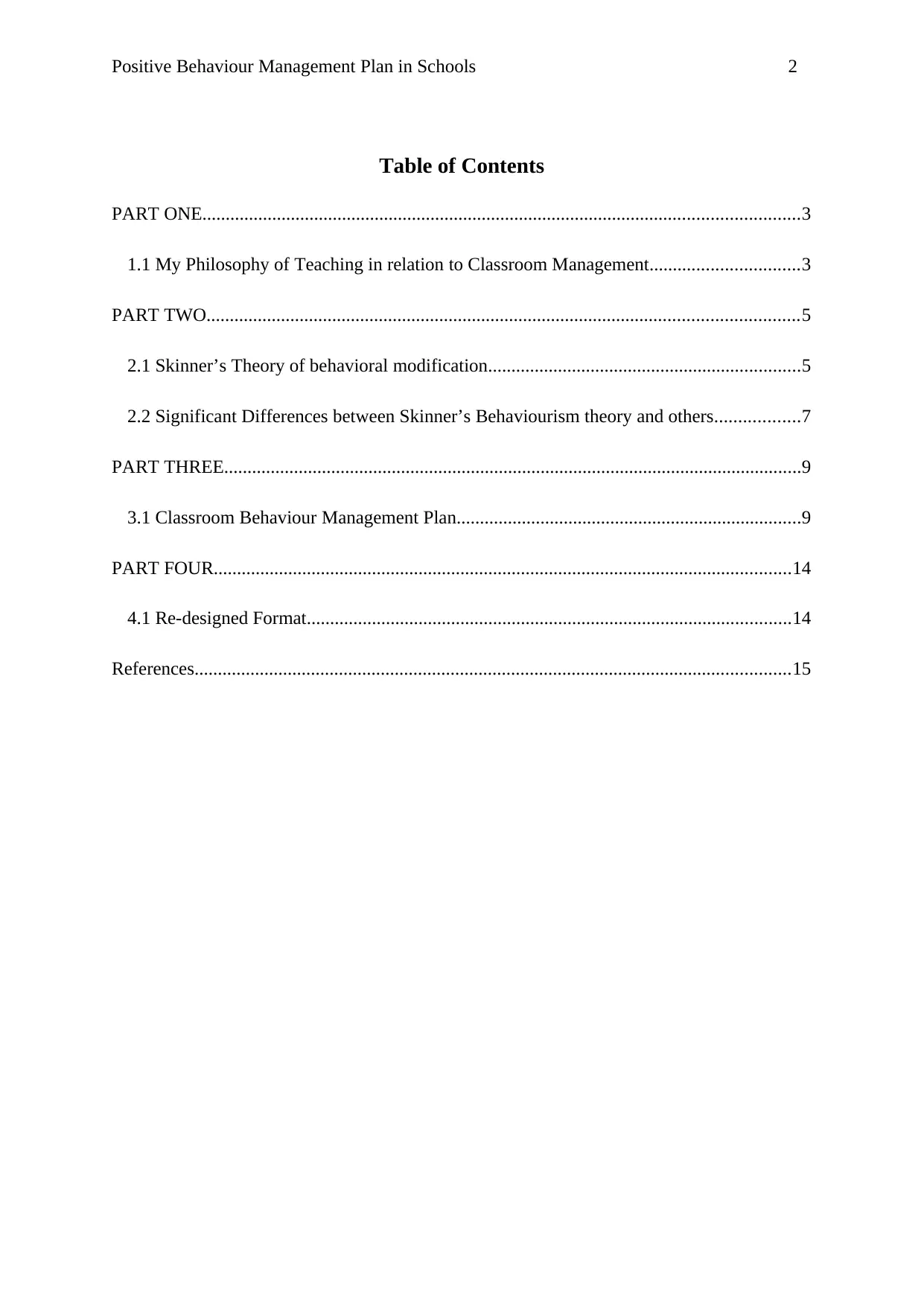
Positive Behaviour Management Plan in Schools 2
Table of Contents
PART ONE................................................................................................................................3
1.1 My Philosophy of Teaching in relation to Classroom Management................................3
PART TWO...............................................................................................................................5
2.1 Skinner’s Theory of behavioral modification...................................................................5
2.2 Significant Differences between Skinner’s Behaviourism theory and others..................7
PART THREE............................................................................................................................9
3.1 Classroom Behaviour Management Plan..........................................................................9
PART FOUR............................................................................................................................14
4.1 Re-designed Format........................................................................................................14
References................................................................................................................................15
Table of Contents
PART ONE................................................................................................................................3
1.1 My Philosophy of Teaching in relation to Classroom Management................................3
PART TWO...............................................................................................................................5
2.1 Skinner’s Theory of behavioral modification...................................................................5
2.2 Significant Differences between Skinner’s Behaviourism theory and others..................7
PART THREE............................................................................................................................9
3.1 Classroom Behaviour Management Plan..........................................................................9
PART FOUR............................................................................................................................14
4.1 Re-designed Format........................................................................................................14
References................................................................................................................................15
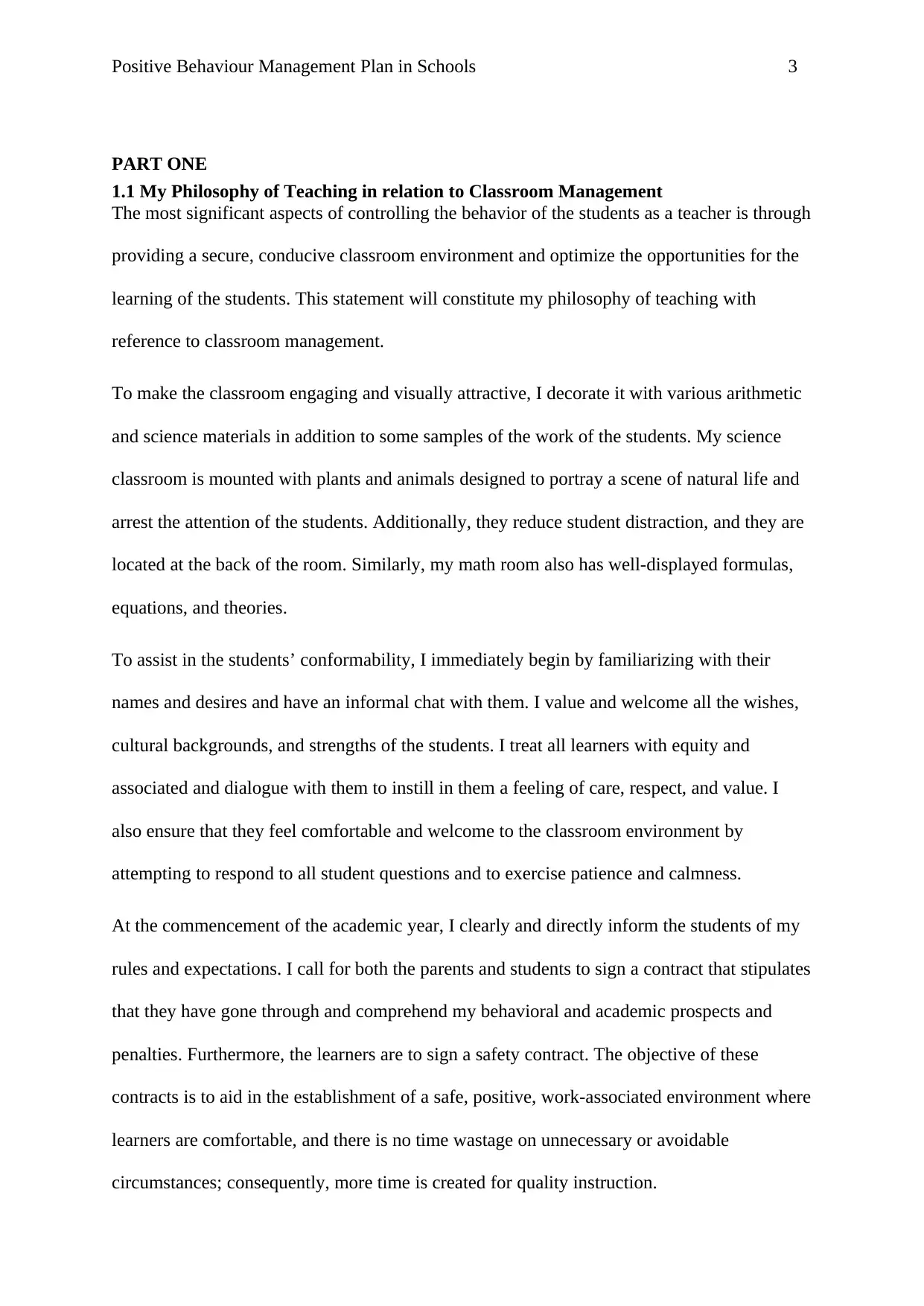
Positive Behaviour Management Plan in Schools 3
PART ONE
1.1 My Philosophy of Teaching in relation to Classroom Management
The most significant aspects of controlling the behavior of the students as a teacher is through
providing a secure, conducive classroom environment and optimize the opportunities for the
learning of the students. This statement will constitute my philosophy of teaching with
reference to classroom management.
To make the classroom engaging and visually attractive, I decorate it with various arithmetic
and science materials in addition to some samples of the work of the students. My science
classroom is mounted with plants and animals designed to portray a scene of natural life and
arrest the attention of the students. Additionally, they reduce student distraction, and they are
located at the back of the room. Similarly, my math room also has well-displayed formulas,
equations, and theories.
To assist in the students’ conformability, I immediately begin by familiarizing with their
names and desires and have an informal chat with them. I value and welcome all the wishes,
cultural backgrounds, and strengths of the students. I treat all learners with equity and
associated and dialogue with them to instill in them a feeling of care, respect, and value. I
also ensure that they feel comfortable and welcome to the classroom environment by
attempting to respond to all student questions and to exercise patience and calmness.
At the commencement of the academic year, I clearly and directly inform the students of my
rules and expectations. I call for both the parents and students to sign a contract that stipulates
that they have gone through and comprehend my behavioral and academic prospects and
penalties. Furthermore, the learners are to sign a safety contract. The objective of these
contracts is to aid in the establishment of a safe, positive, work-associated environment where
learners are comfortable, and there is no time wastage on unnecessary or avoidable
circumstances; consequently, more time is created for quality instruction.
PART ONE
1.1 My Philosophy of Teaching in relation to Classroom Management
The most significant aspects of controlling the behavior of the students as a teacher is through
providing a secure, conducive classroom environment and optimize the opportunities for the
learning of the students. This statement will constitute my philosophy of teaching with
reference to classroom management.
To make the classroom engaging and visually attractive, I decorate it with various arithmetic
and science materials in addition to some samples of the work of the students. My science
classroom is mounted with plants and animals designed to portray a scene of natural life and
arrest the attention of the students. Additionally, they reduce student distraction, and they are
located at the back of the room. Similarly, my math room also has well-displayed formulas,
equations, and theories.
To assist in the students’ conformability, I immediately begin by familiarizing with their
names and desires and have an informal chat with them. I value and welcome all the wishes,
cultural backgrounds, and strengths of the students. I treat all learners with equity and
associated and dialogue with them to instill in them a feeling of care, respect, and value. I
also ensure that they feel comfortable and welcome to the classroom environment by
attempting to respond to all student questions and to exercise patience and calmness.
At the commencement of the academic year, I clearly and directly inform the students of my
rules and expectations. I call for both the parents and students to sign a contract that stipulates
that they have gone through and comprehend my behavioral and academic prospects and
penalties. Furthermore, the learners are to sign a safety contract. The objective of these
contracts is to aid in the establishment of a safe, positive, work-associated environment where
learners are comfortable, and there is no time wastage on unnecessary or avoidable
circumstances; consequently, more time is created for quality instruction.
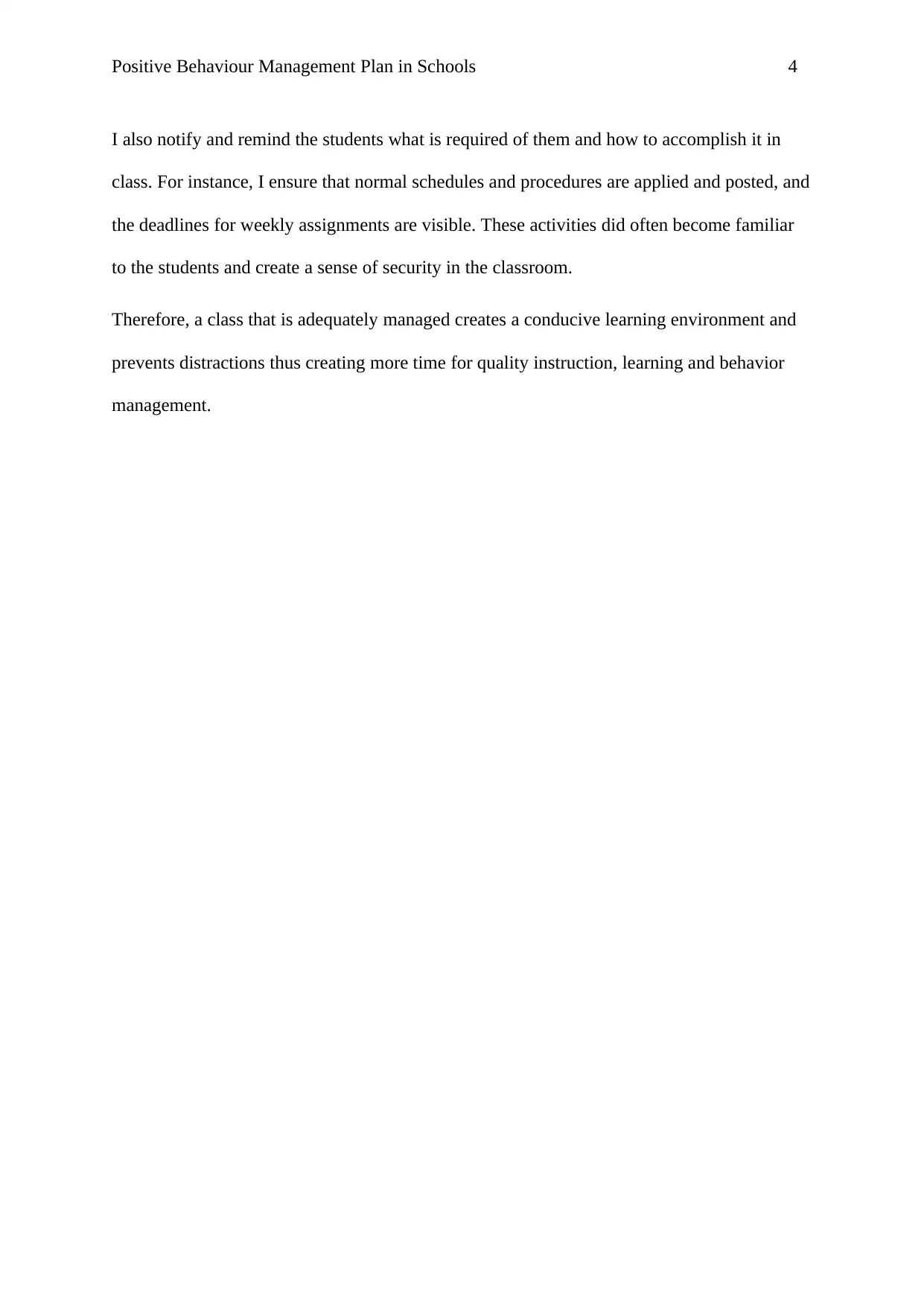
Positive Behaviour Management Plan in Schools 4
I also notify and remind the students what is required of them and how to accomplish it in
class. For instance, I ensure that normal schedules and procedures are applied and posted, and
the deadlines for weekly assignments are visible. These activities did often become familiar
to the students and create a sense of security in the classroom.
Therefore, a class that is adequately managed creates a conducive learning environment and
prevents distractions thus creating more time for quality instruction, learning and behavior
management.
I also notify and remind the students what is required of them and how to accomplish it in
class. For instance, I ensure that normal schedules and procedures are applied and posted, and
the deadlines for weekly assignments are visible. These activities did often become familiar
to the students and create a sense of security in the classroom.
Therefore, a class that is adequately managed creates a conducive learning environment and
prevents distractions thus creating more time for quality instruction, learning and behavior
management.
Secure Best Marks with AI Grader
Need help grading? Try our AI Grader for instant feedback on your assignments.
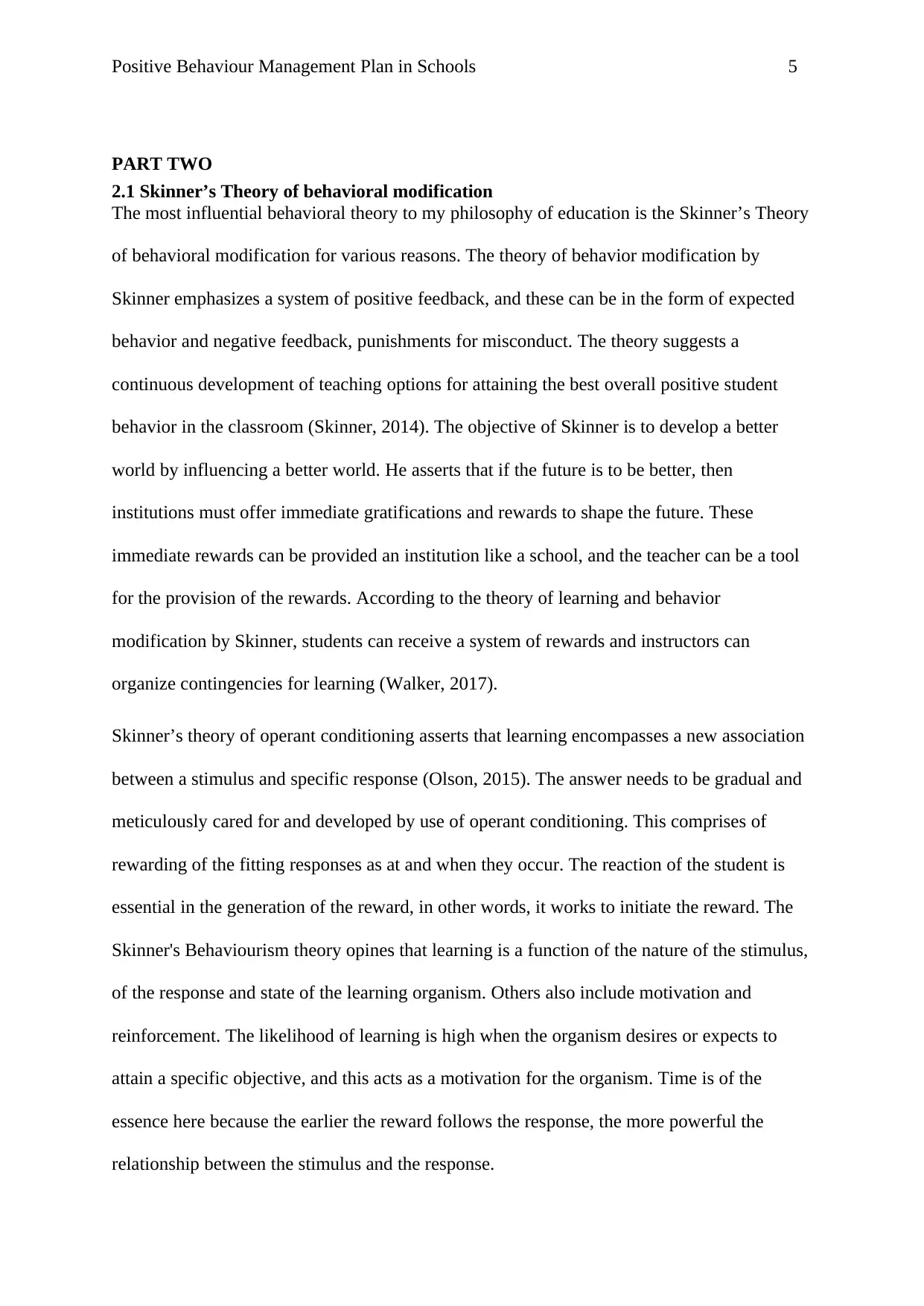
Positive Behaviour Management Plan in Schools 5
PART TWO
2.1 Skinner’s Theory of behavioral modification
The most influential behavioral theory to my philosophy of education is the Skinner’s Theory
of behavioral modification for various reasons. The theory of behavior modification by
Skinner emphasizes a system of positive feedback, and these can be in the form of expected
behavior and negative feedback, punishments for misconduct. The theory suggests a
continuous development of teaching options for attaining the best overall positive student
behavior in the classroom (Skinner, 2014). The objective of Skinner is to develop a better
world by influencing a better world. He asserts that if the future is to be better, then
institutions must offer immediate gratifications and rewards to shape the future. These
immediate rewards can be provided an institution like a school, and the teacher can be a tool
for the provision of the rewards. According to the theory of learning and behavior
modification by Skinner, students can receive a system of rewards and instructors can
organize contingencies for learning (Walker, 2017).
Skinner’s theory of operant conditioning asserts that learning encompasses a new association
between a stimulus and specific response (Olson, 2015). The answer needs to be gradual and
meticulously cared for and developed by use of operant conditioning. This comprises of
rewarding of the fitting responses as at and when they occur. The reaction of the student is
essential in the generation of the reward, in other words, it works to initiate the reward. The
Skinner's Behaviourism theory opines that learning is a function of the nature of the stimulus,
of the response and state of the learning organism. Others also include motivation and
reinforcement. The likelihood of learning is high when the organism desires or expects to
attain a specific objective, and this acts as a motivation for the organism. Time is of the
essence here because the earlier the reward follows the response, the more powerful the
relationship between the stimulus and the response.
PART TWO
2.1 Skinner’s Theory of behavioral modification
The most influential behavioral theory to my philosophy of education is the Skinner’s Theory
of behavioral modification for various reasons. The theory of behavior modification by
Skinner emphasizes a system of positive feedback, and these can be in the form of expected
behavior and negative feedback, punishments for misconduct. The theory suggests a
continuous development of teaching options for attaining the best overall positive student
behavior in the classroom (Skinner, 2014). The objective of Skinner is to develop a better
world by influencing a better world. He asserts that if the future is to be better, then
institutions must offer immediate gratifications and rewards to shape the future. These
immediate rewards can be provided an institution like a school, and the teacher can be a tool
for the provision of the rewards. According to the theory of learning and behavior
modification by Skinner, students can receive a system of rewards and instructors can
organize contingencies for learning (Walker, 2017).
Skinner’s theory of operant conditioning asserts that learning encompasses a new association
between a stimulus and specific response (Olson, 2015). The answer needs to be gradual and
meticulously cared for and developed by use of operant conditioning. This comprises of
rewarding of the fitting responses as at and when they occur. The reaction of the student is
essential in the generation of the reward, in other words, it works to initiate the reward. The
Skinner's Behaviourism theory opines that learning is a function of the nature of the stimulus,
of the response and state of the learning organism. Others also include motivation and
reinforcement. The likelihood of learning is high when the organism desires or expects to
attain a specific objective, and this acts as a motivation for the organism. Time is of the
essence here because the earlier the reward follows the response, the more powerful the
relationship between the stimulus and the response.
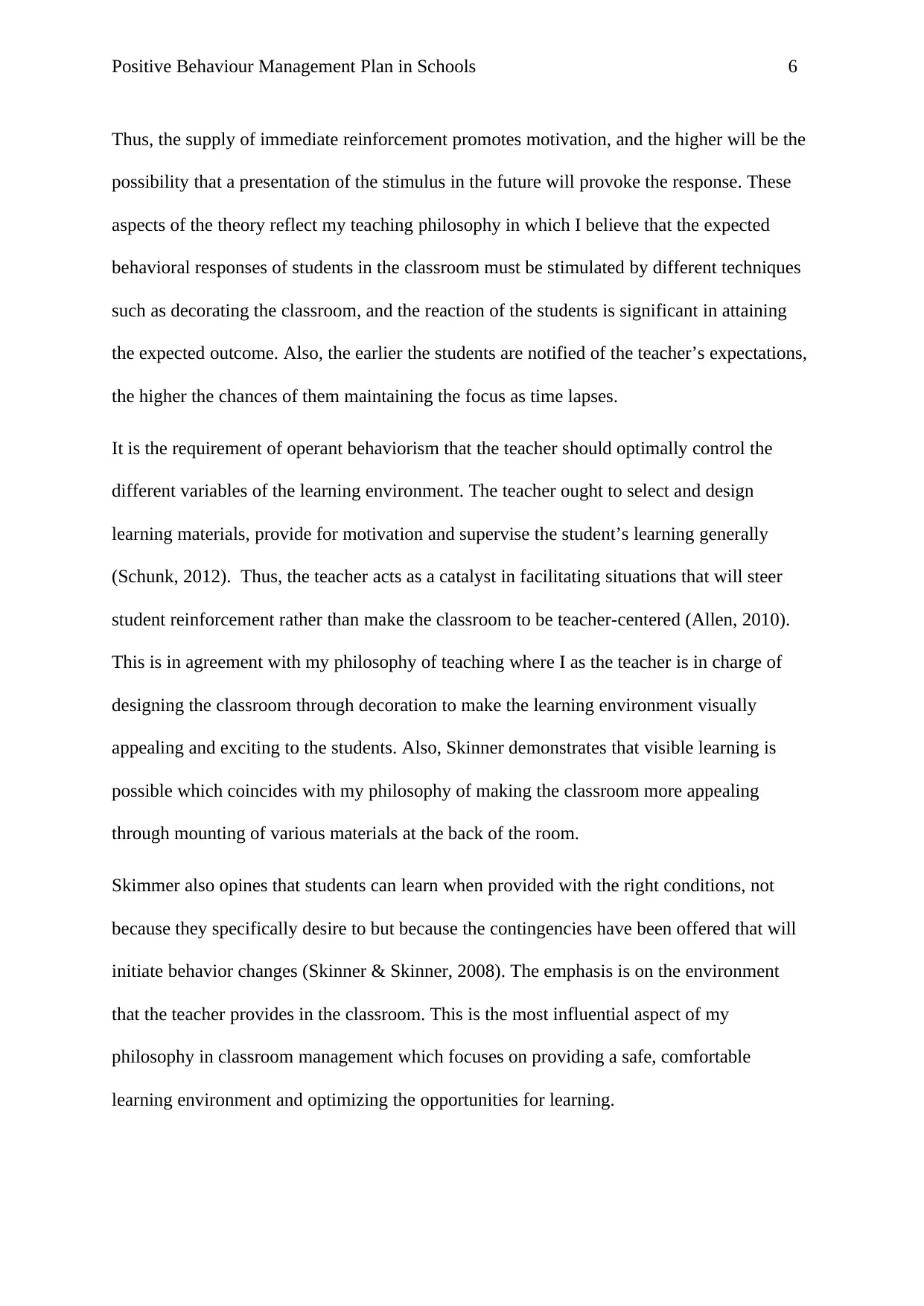
Positive Behaviour Management Plan in Schools 6
Thus, the supply of immediate reinforcement promotes motivation, and the higher will be the
possibility that a presentation of the stimulus in the future will provoke the response. These
aspects of the theory reflect my teaching philosophy in which I believe that the expected
behavioral responses of students in the classroom must be stimulated by different techniques
such as decorating the classroom, and the reaction of the students is significant in attaining
the expected outcome. Also, the earlier the students are notified of the teacher’s expectations,
the higher the chances of them maintaining the focus as time lapses.
It is the requirement of operant behaviorism that the teacher should optimally control the
different variables of the learning environment. The teacher ought to select and design
learning materials, provide for motivation and supervise the student’s learning generally
(Schunk, 2012). Thus, the teacher acts as a catalyst in facilitating situations that will steer
student reinforcement rather than make the classroom to be teacher-centered (Allen, 2010).
This is in agreement with my philosophy of teaching where I as the teacher is in charge of
designing the classroom through decoration to make the learning environment visually
appealing and exciting to the students. Also, Skinner demonstrates that visible learning is
possible which coincides with my philosophy of making the classroom more appealing
through mounting of various materials at the back of the room.
Skimmer also opines that students can learn when provided with the right conditions, not
because they specifically desire to but because the contingencies have been offered that will
initiate behavior changes (Skinner & Skinner, 2008). The emphasis is on the environment
that the teacher provides in the classroom. This is the most influential aspect of my
philosophy in classroom management which focuses on providing a safe, comfortable
learning environment and optimizing the opportunities for learning.
Thus, the supply of immediate reinforcement promotes motivation, and the higher will be the
possibility that a presentation of the stimulus in the future will provoke the response. These
aspects of the theory reflect my teaching philosophy in which I believe that the expected
behavioral responses of students in the classroom must be stimulated by different techniques
such as decorating the classroom, and the reaction of the students is significant in attaining
the expected outcome. Also, the earlier the students are notified of the teacher’s expectations,
the higher the chances of them maintaining the focus as time lapses.
It is the requirement of operant behaviorism that the teacher should optimally control the
different variables of the learning environment. The teacher ought to select and design
learning materials, provide for motivation and supervise the student’s learning generally
(Schunk, 2012). Thus, the teacher acts as a catalyst in facilitating situations that will steer
student reinforcement rather than make the classroom to be teacher-centered (Allen, 2010).
This is in agreement with my philosophy of teaching where I as the teacher is in charge of
designing the classroom through decoration to make the learning environment visually
appealing and exciting to the students. Also, Skinner demonstrates that visible learning is
possible which coincides with my philosophy of making the classroom more appealing
through mounting of various materials at the back of the room.
Skimmer also opines that students can learn when provided with the right conditions, not
because they specifically desire to but because the contingencies have been offered that will
initiate behavior changes (Skinner & Skinner, 2008). The emphasis is on the environment
that the teacher provides in the classroom. This is the most influential aspect of my
philosophy in classroom management which focuses on providing a safe, comfortable
learning environment and optimizing the opportunities for learning.
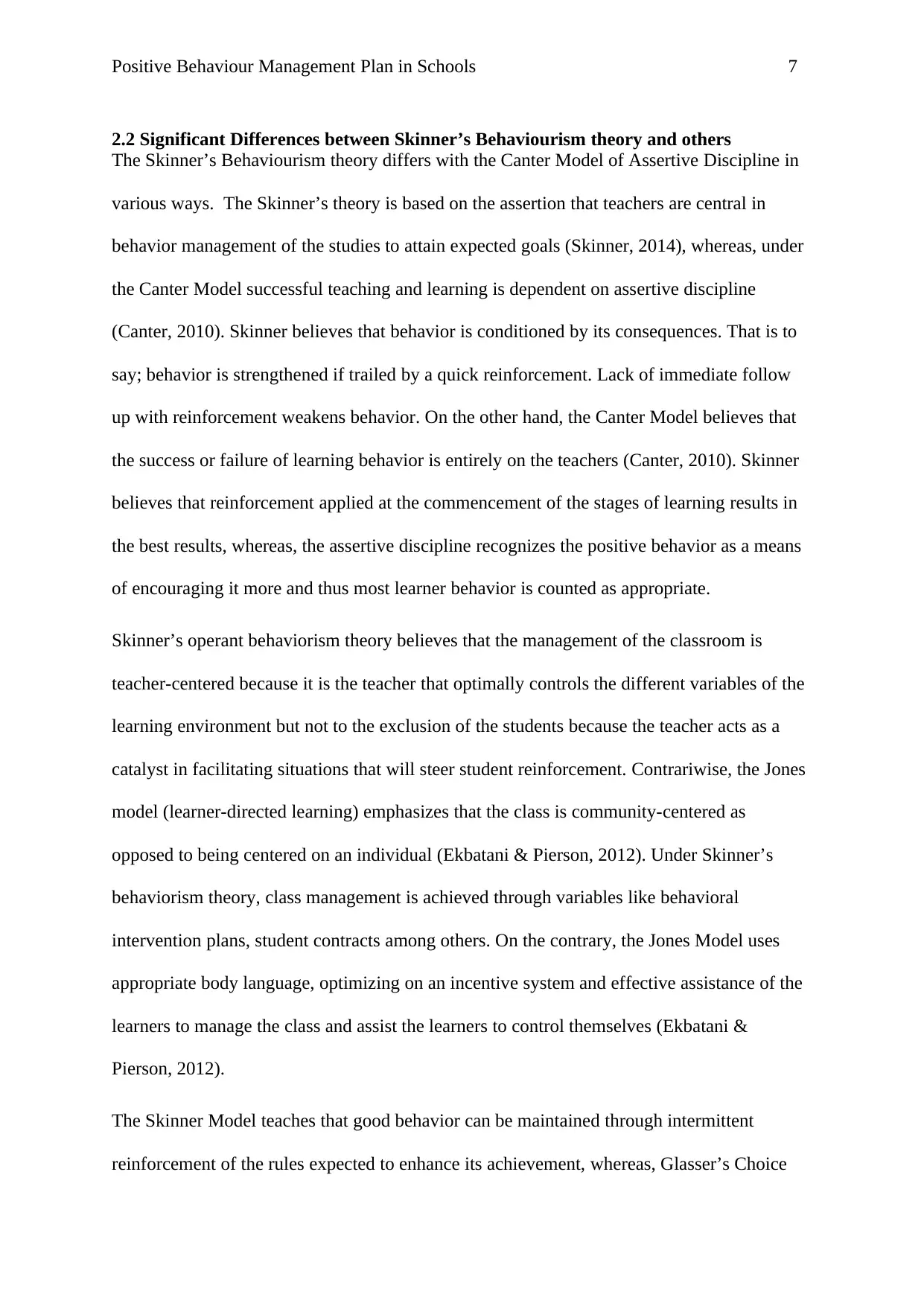
Positive Behaviour Management Plan in Schools 7
2.2 Significant Differences between Skinner’s Behaviourism theory and others
The Skinner’s Behaviourism theory differs with the Canter Model of Assertive Discipline in
various ways. The Skinner’s theory is based on the assertion that teachers are central in
behavior management of the studies to attain expected goals (Skinner, 2014), whereas, under
the Canter Model successful teaching and learning is dependent on assertive discipline
(Canter, 2010). Skinner believes that behavior is conditioned by its consequences. That is to
say; behavior is strengthened if trailed by a quick reinforcement. Lack of immediate follow
up with reinforcement weakens behavior. On the other hand, the Canter Model believes that
the success or failure of learning behavior is entirely on the teachers (Canter, 2010). Skinner
believes that reinforcement applied at the commencement of the stages of learning results in
the best results, whereas, the assertive discipline recognizes the positive behavior as a means
of encouraging it more and thus most learner behavior is counted as appropriate.
Skinner’s operant behaviorism theory believes that the management of the classroom is
teacher-centered because it is the teacher that optimally controls the different variables of the
learning environment but not to the exclusion of the students because the teacher acts as a
catalyst in facilitating situations that will steer student reinforcement. Contrariwise, the Jones
model (learner-directed learning) emphasizes that the class is community-centered as
opposed to being centered on an individual (Ekbatani & Pierson, 2012). Under Skinner’s
behaviorism theory, class management is achieved through variables like behavioral
intervention plans, student contracts among others. On the contrary, the Jones Model uses
appropriate body language, optimizing on an incentive system and effective assistance of the
learners to manage the class and assist the learners to control themselves (Ekbatani &
Pierson, 2012).
The Skinner Model teaches that good behavior can be maintained through intermittent
reinforcement of the rules expected to enhance its achievement, whereas, Glasser’s Choice
2.2 Significant Differences between Skinner’s Behaviourism theory and others
The Skinner’s Behaviourism theory differs with the Canter Model of Assertive Discipline in
various ways. The Skinner’s theory is based on the assertion that teachers are central in
behavior management of the studies to attain expected goals (Skinner, 2014), whereas, under
the Canter Model successful teaching and learning is dependent on assertive discipline
(Canter, 2010). Skinner believes that behavior is conditioned by its consequences. That is to
say; behavior is strengthened if trailed by a quick reinforcement. Lack of immediate follow
up with reinforcement weakens behavior. On the other hand, the Canter Model believes that
the success or failure of learning behavior is entirely on the teachers (Canter, 2010). Skinner
believes that reinforcement applied at the commencement of the stages of learning results in
the best results, whereas, the assertive discipline recognizes the positive behavior as a means
of encouraging it more and thus most learner behavior is counted as appropriate.
Skinner’s operant behaviorism theory believes that the management of the classroom is
teacher-centered because it is the teacher that optimally controls the different variables of the
learning environment but not to the exclusion of the students because the teacher acts as a
catalyst in facilitating situations that will steer student reinforcement. Contrariwise, the Jones
model (learner-directed learning) emphasizes that the class is community-centered as
opposed to being centered on an individual (Ekbatani & Pierson, 2012). Under Skinner’s
behaviorism theory, class management is achieved through variables like behavioral
intervention plans, student contracts among others. On the contrary, the Jones Model uses
appropriate body language, optimizing on an incentive system and effective assistance of the
learners to manage the class and assist the learners to control themselves (Ekbatani &
Pierson, 2012).
The Skinner Model teaches that good behavior can be maintained through intermittent
reinforcement of the rules expected to enhance its achievement, whereas, Glasser’s Choice
Paraphrase This Document
Need a fresh take? Get an instant paraphrase of this document with our AI Paraphraser
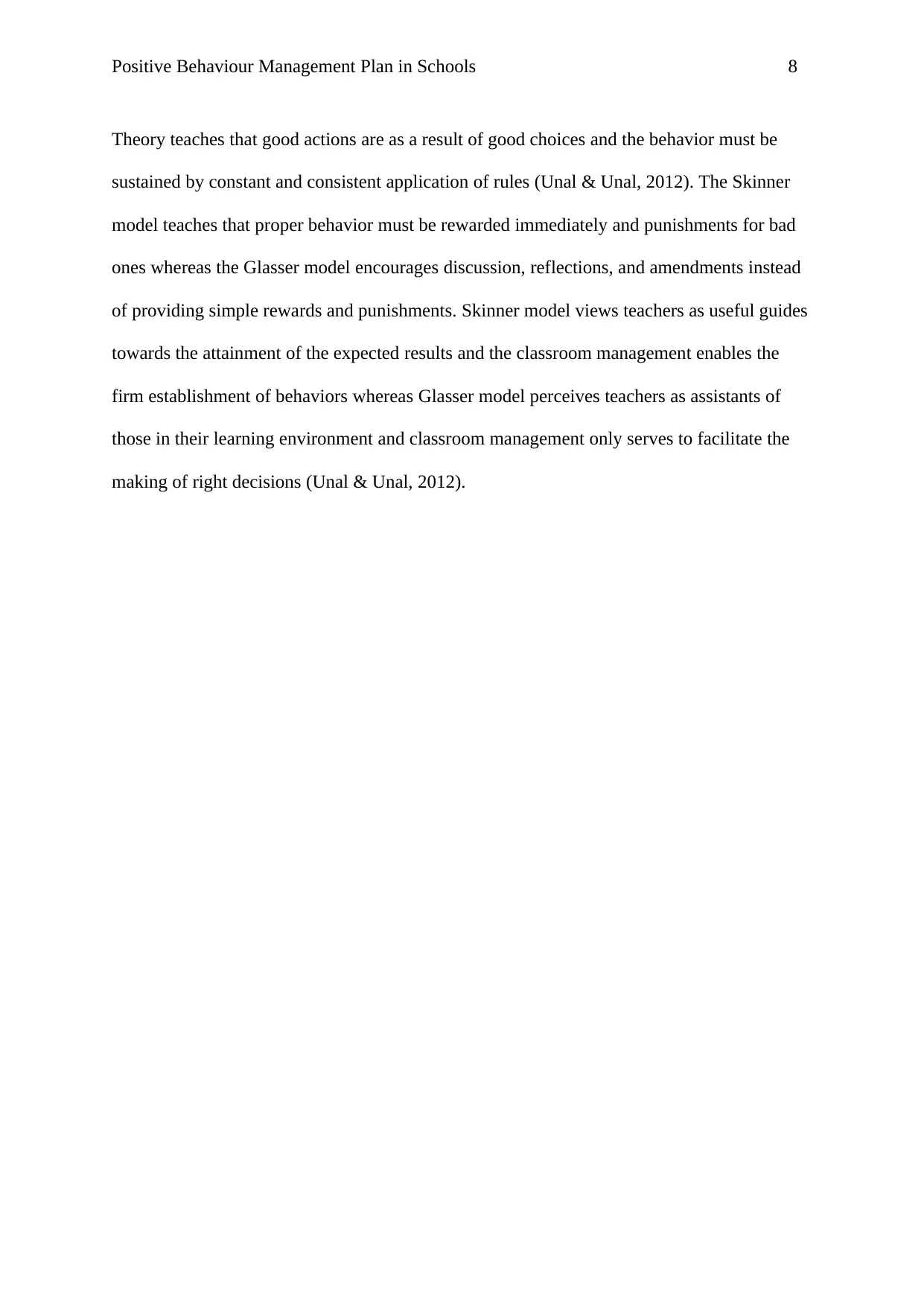
Positive Behaviour Management Plan in Schools 8
Theory teaches that good actions are as a result of good choices and the behavior must be
sustained by constant and consistent application of rules (Unal & Unal, 2012). The Skinner
model teaches that proper behavior must be rewarded immediately and punishments for bad
ones whereas the Glasser model encourages discussion, reflections, and amendments instead
of providing simple rewards and punishments. Skinner model views teachers as useful guides
towards the attainment of the expected results and the classroom management enables the
firm establishment of behaviors whereas Glasser model perceives teachers as assistants of
those in their learning environment and classroom management only serves to facilitate the
making of right decisions (Unal & Unal, 2012).
Theory teaches that good actions are as a result of good choices and the behavior must be
sustained by constant and consistent application of rules (Unal & Unal, 2012). The Skinner
model teaches that proper behavior must be rewarded immediately and punishments for bad
ones whereas the Glasser model encourages discussion, reflections, and amendments instead
of providing simple rewards and punishments. Skinner model views teachers as useful guides
towards the attainment of the expected results and the classroom management enables the
firm establishment of behaviors whereas Glasser model perceives teachers as assistants of
those in their learning environment and classroom management only serves to facilitate the
making of right decisions (Unal & Unal, 2012).
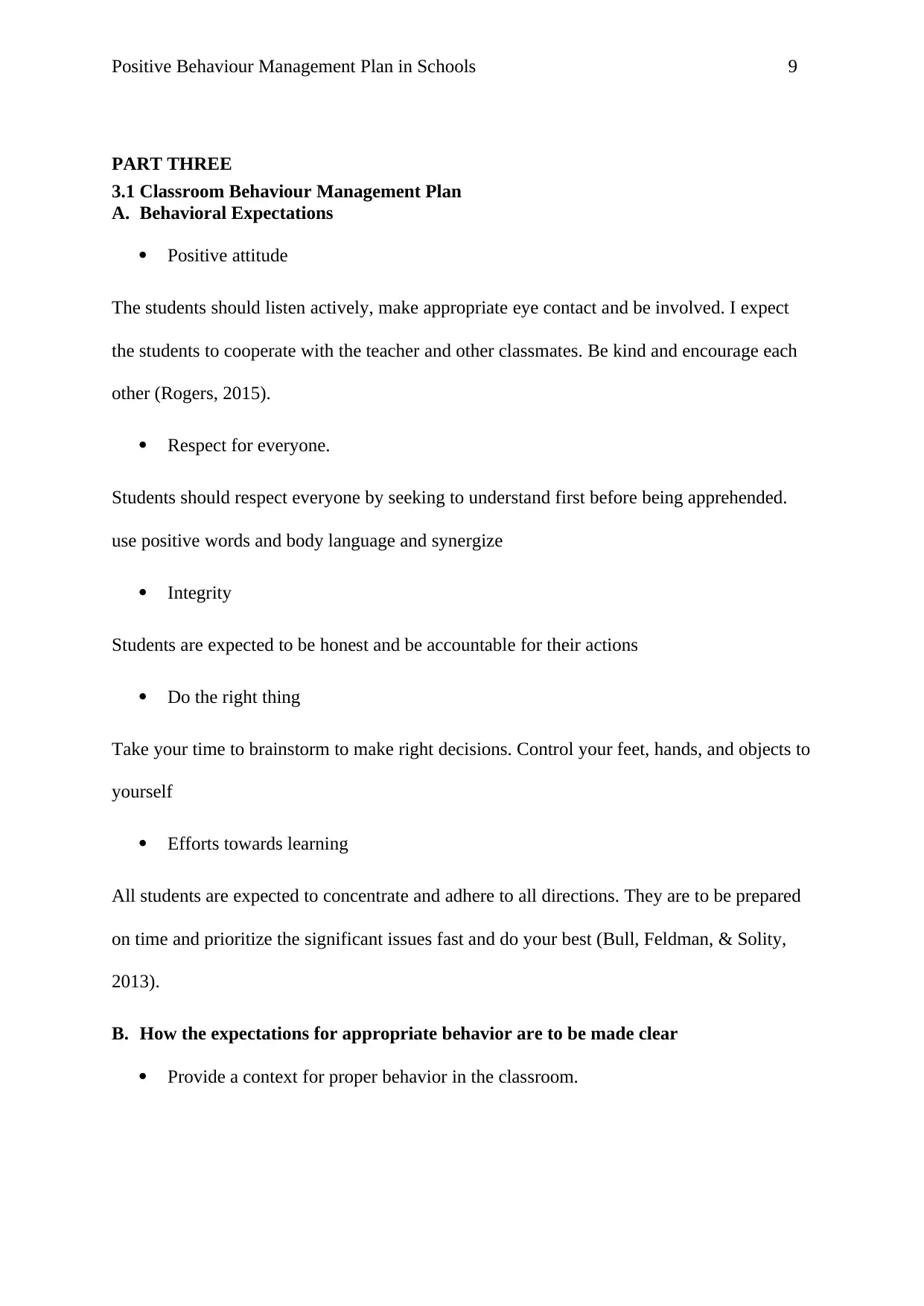
Positive Behaviour Management Plan in Schools 9
PART THREE
3.1 Classroom Behaviour Management Plan
A. Behavioral Expectations
Positive attitude
The students should listen actively, make appropriate eye contact and be involved. I expect
the students to cooperate with the teacher and other classmates. Be kind and encourage each
other (Rogers, 2015).
Respect for everyone.
Students should respect everyone by seeking to understand first before being apprehended.
use positive words and body language and synergize
Integrity
Students are expected to be honest and be accountable for their actions
Do the right thing
Take your time to brainstorm to make right decisions. Control your feet, hands, and objects to
yourself
Efforts towards learning
All students are expected to concentrate and adhere to all directions. They are to be prepared
on time and prioritize the significant issues fast and do your best (Bull, Feldman, & Solity,
2013).
B. How the expectations for appropriate behavior are to be made clear
Provide a context for proper behavior in the classroom.
PART THREE
3.1 Classroom Behaviour Management Plan
A. Behavioral Expectations
Positive attitude
The students should listen actively, make appropriate eye contact and be involved. I expect
the students to cooperate with the teacher and other classmates. Be kind and encourage each
other (Rogers, 2015).
Respect for everyone.
Students should respect everyone by seeking to understand first before being apprehended.
use positive words and body language and synergize
Integrity
Students are expected to be honest and be accountable for their actions
Do the right thing
Take your time to brainstorm to make right decisions. Control your feet, hands, and objects to
yourself
Efforts towards learning
All students are expected to concentrate and adhere to all directions. They are to be prepared
on time and prioritize the significant issues fast and do your best (Bull, Feldman, & Solity,
2013).
B. How the expectations for appropriate behavior are to be made clear
Provide a context for proper behavior in the classroom.
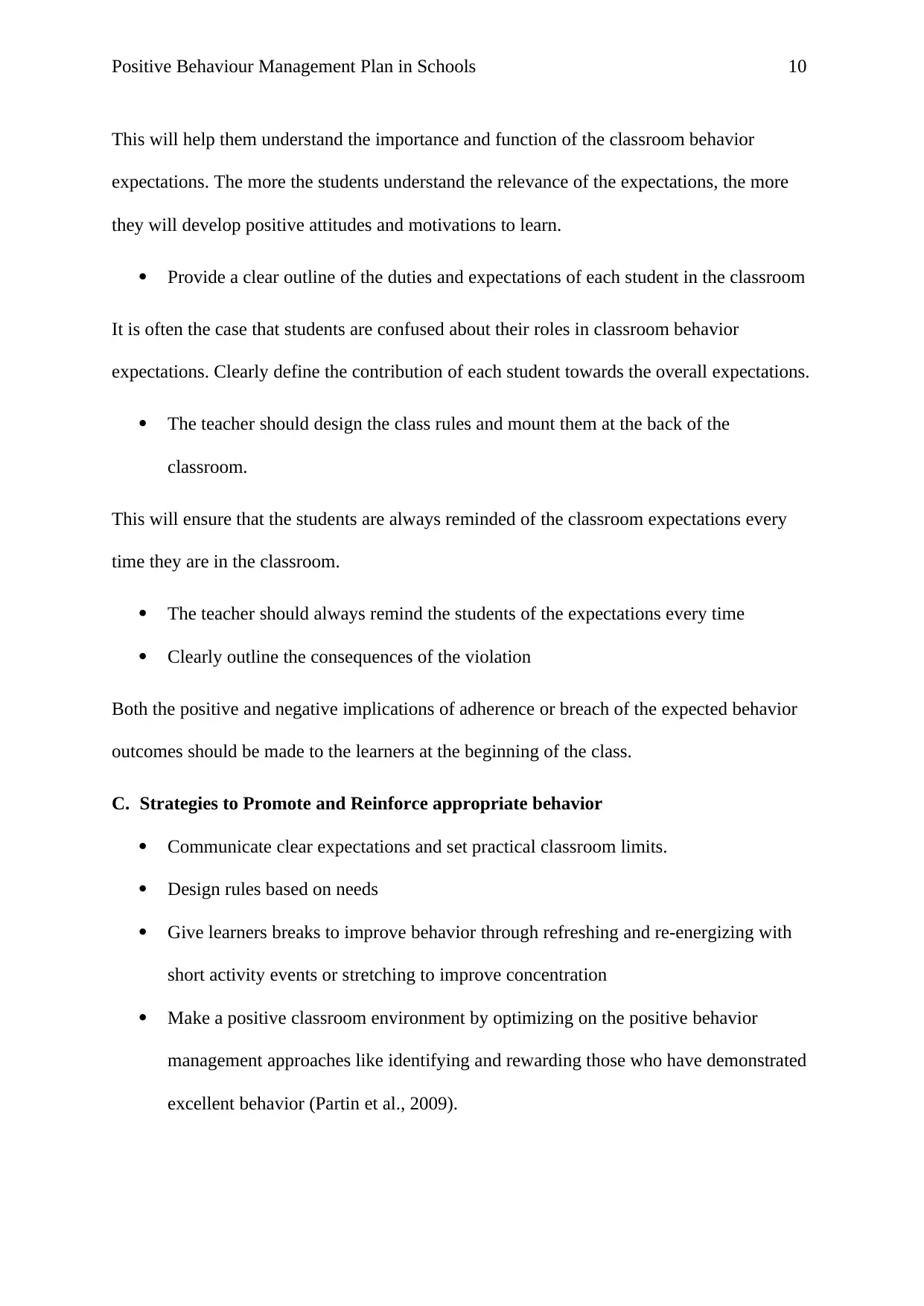
Positive Behaviour Management Plan in Schools 10
This will help them understand the importance and function of the classroom behavior
expectations. The more the students understand the relevance of the expectations, the more
they will develop positive attitudes and motivations to learn.
Provide a clear outline of the duties and expectations of each student in the classroom
It is often the case that students are confused about their roles in classroom behavior
expectations. Clearly define the contribution of each student towards the overall expectations.
The teacher should design the class rules and mount them at the back of the
classroom.
This will ensure that the students are always reminded of the classroom expectations every
time they are in the classroom.
The teacher should always remind the students of the expectations every time
Clearly outline the consequences of the violation
Both the positive and negative implications of adherence or breach of the expected behavior
outcomes should be made to the learners at the beginning of the class.
C. Strategies to Promote and Reinforce appropriate behavior
Communicate clear expectations and set practical classroom limits.
Design rules based on needs
Give learners breaks to improve behavior through refreshing and re-energizing with
short activity events or stretching to improve concentration
Make a positive classroom environment by optimizing on the positive behavior
management approaches like identifying and rewarding those who have demonstrated
excellent behavior (Partin et al., 2009).
This will help them understand the importance and function of the classroom behavior
expectations. The more the students understand the relevance of the expectations, the more
they will develop positive attitudes and motivations to learn.
Provide a clear outline of the duties and expectations of each student in the classroom
It is often the case that students are confused about their roles in classroom behavior
expectations. Clearly define the contribution of each student towards the overall expectations.
The teacher should design the class rules and mount them at the back of the
classroom.
This will ensure that the students are always reminded of the classroom expectations every
time they are in the classroom.
The teacher should always remind the students of the expectations every time
Clearly outline the consequences of the violation
Both the positive and negative implications of adherence or breach of the expected behavior
outcomes should be made to the learners at the beginning of the class.
C. Strategies to Promote and Reinforce appropriate behavior
Communicate clear expectations and set practical classroom limits.
Design rules based on needs
Give learners breaks to improve behavior through refreshing and re-energizing with
short activity events or stretching to improve concentration
Make a positive classroom environment by optimizing on the positive behavior
management approaches like identifying and rewarding those who have demonstrated
excellent behavior (Partin et al., 2009).
Secure Best Marks with AI Grader
Need help grading? Try our AI Grader for instant feedback on your assignments.
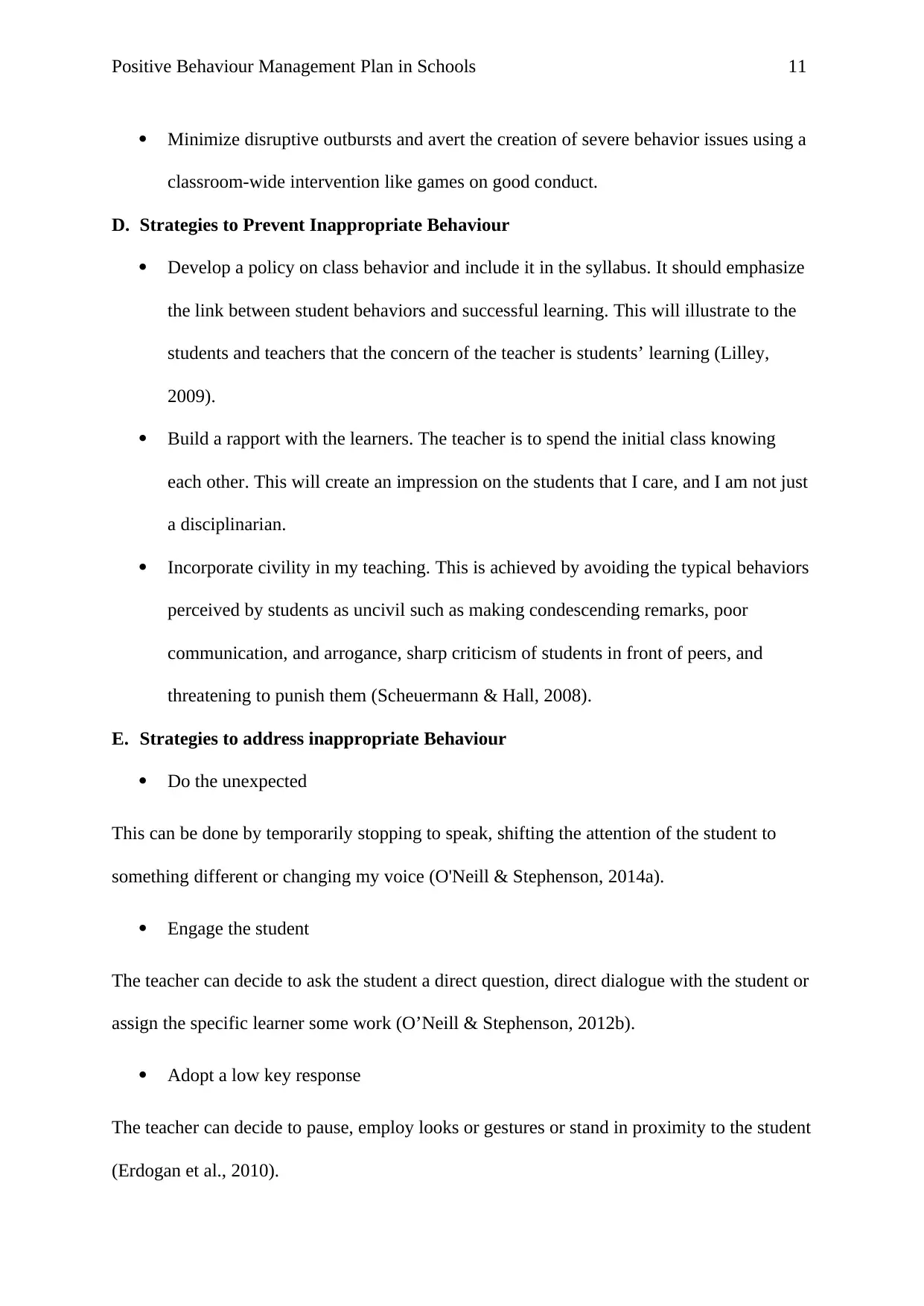
Positive Behaviour Management Plan in Schools 11
Minimize disruptive outbursts and avert the creation of severe behavior issues using a
classroom-wide intervention like games on good conduct.
D. Strategies to Prevent Inappropriate Behaviour
Develop a policy on class behavior and include it in the syllabus. It should emphasize
the link between student behaviors and successful learning. This will illustrate to the
students and teachers that the concern of the teacher is students’ learning (Lilley,
2009).
Build a rapport with the learners. The teacher is to spend the initial class knowing
each other. This will create an impression on the students that I care, and I am not just
a disciplinarian.
Incorporate civility in my teaching. This is achieved by avoiding the typical behaviors
perceived by students as uncivil such as making condescending remarks, poor
communication, and arrogance, sharp criticism of students in front of peers, and
threatening to punish them (Scheuermann & Hall, 2008).
E. Strategies to address inappropriate Behaviour
Do the unexpected
This can be done by temporarily stopping to speak, shifting the attention of the student to
something different or changing my voice (O'Neill & Stephenson, 2014a).
Engage the student
The teacher can decide to ask the student a direct question, direct dialogue with the student or
assign the specific learner some work (O’Neill & Stephenson, 2012b).
Adopt a low key response
The teacher can decide to pause, employ looks or gestures or stand in proximity to the student
(Erdogan et al., 2010).
Minimize disruptive outbursts and avert the creation of severe behavior issues using a
classroom-wide intervention like games on good conduct.
D. Strategies to Prevent Inappropriate Behaviour
Develop a policy on class behavior and include it in the syllabus. It should emphasize
the link between student behaviors and successful learning. This will illustrate to the
students and teachers that the concern of the teacher is students’ learning (Lilley,
2009).
Build a rapport with the learners. The teacher is to spend the initial class knowing
each other. This will create an impression on the students that I care, and I am not just
a disciplinarian.
Incorporate civility in my teaching. This is achieved by avoiding the typical behaviors
perceived by students as uncivil such as making condescending remarks, poor
communication, and arrogance, sharp criticism of students in front of peers, and
threatening to punish them (Scheuermann & Hall, 2008).
E. Strategies to address inappropriate Behaviour
Do the unexpected
This can be done by temporarily stopping to speak, shifting the attention of the student to
something different or changing my voice (O'Neill & Stephenson, 2014a).
Engage the student
The teacher can decide to ask the student a direct question, direct dialogue with the student or
assign the specific learner some work (O’Neill & Stephenson, 2012b).
Adopt a low key response
The teacher can decide to pause, employ looks or gestures or stand in proximity to the student
(Erdogan et al., 2010).
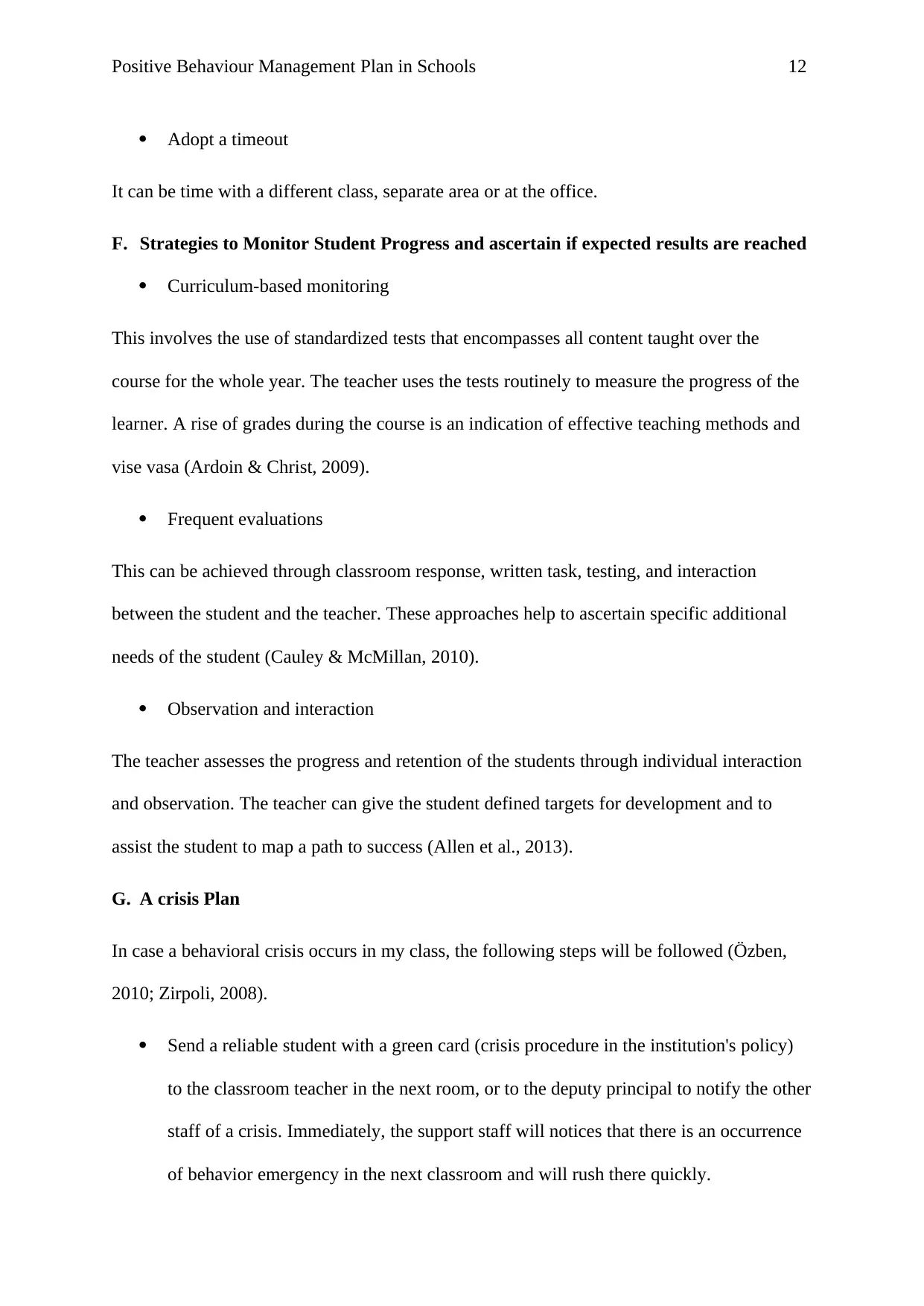
Positive Behaviour Management Plan in Schools 12
Adopt a timeout
It can be time with a different class, separate area or at the office.
F. Strategies to Monitor Student Progress and ascertain if expected results are reached
Curriculum-based monitoring
This involves the use of standardized tests that encompasses all content taught over the
course for the whole year. The teacher uses the tests routinely to measure the progress of the
learner. A rise of grades during the course is an indication of effective teaching methods and
vise vasa (Ardoin & Christ, 2009).
Frequent evaluations
This can be achieved through classroom response, written task, testing, and interaction
between the student and the teacher. These approaches help to ascertain specific additional
needs of the student (Cauley & McMillan, 2010).
Observation and interaction
The teacher assesses the progress and retention of the students through individual interaction
and observation. The teacher can give the student defined targets for development and to
assist the student to map a path to success (Allen et al., 2013).
G. A crisis Plan
In case a behavioral crisis occurs in my class, the following steps will be followed (Özben,
2010; Zirpoli, 2008).
Send a reliable student with a green card (crisis procedure in the institution's policy)
to the classroom teacher in the next room, or to the deputy principal to notify the other
staff of a crisis. Immediately, the support staff will notices that there is an occurrence
of behavior emergency in the next classroom and will rush there quickly.
Adopt a timeout
It can be time with a different class, separate area or at the office.
F. Strategies to Monitor Student Progress and ascertain if expected results are reached
Curriculum-based monitoring
This involves the use of standardized tests that encompasses all content taught over the
course for the whole year. The teacher uses the tests routinely to measure the progress of the
learner. A rise of grades during the course is an indication of effective teaching methods and
vise vasa (Ardoin & Christ, 2009).
Frequent evaluations
This can be achieved through classroom response, written task, testing, and interaction
between the student and the teacher. These approaches help to ascertain specific additional
needs of the student (Cauley & McMillan, 2010).
Observation and interaction
The teacher assesses the progress and retention of the students through individual interaction
and observation. The teacher can give the student defined targets for development and to
assist the student to map a path to success (Allen et al., 2013).
G. A crisis Plan
In case a behavioral crisis occurs in my class, the following steps will be followed (Özben,
2010; Zirpoli, 2008).
Send a reliable student with a green card (crisis procedure in the institution's policy)
to the classroom teacher in the next room, or to the deputy principal to notify the other
staff of a crisis. Immediately, the support staff will notices that there is an occurrence
of behavior emergency in the next classroom and will rush there quickly.
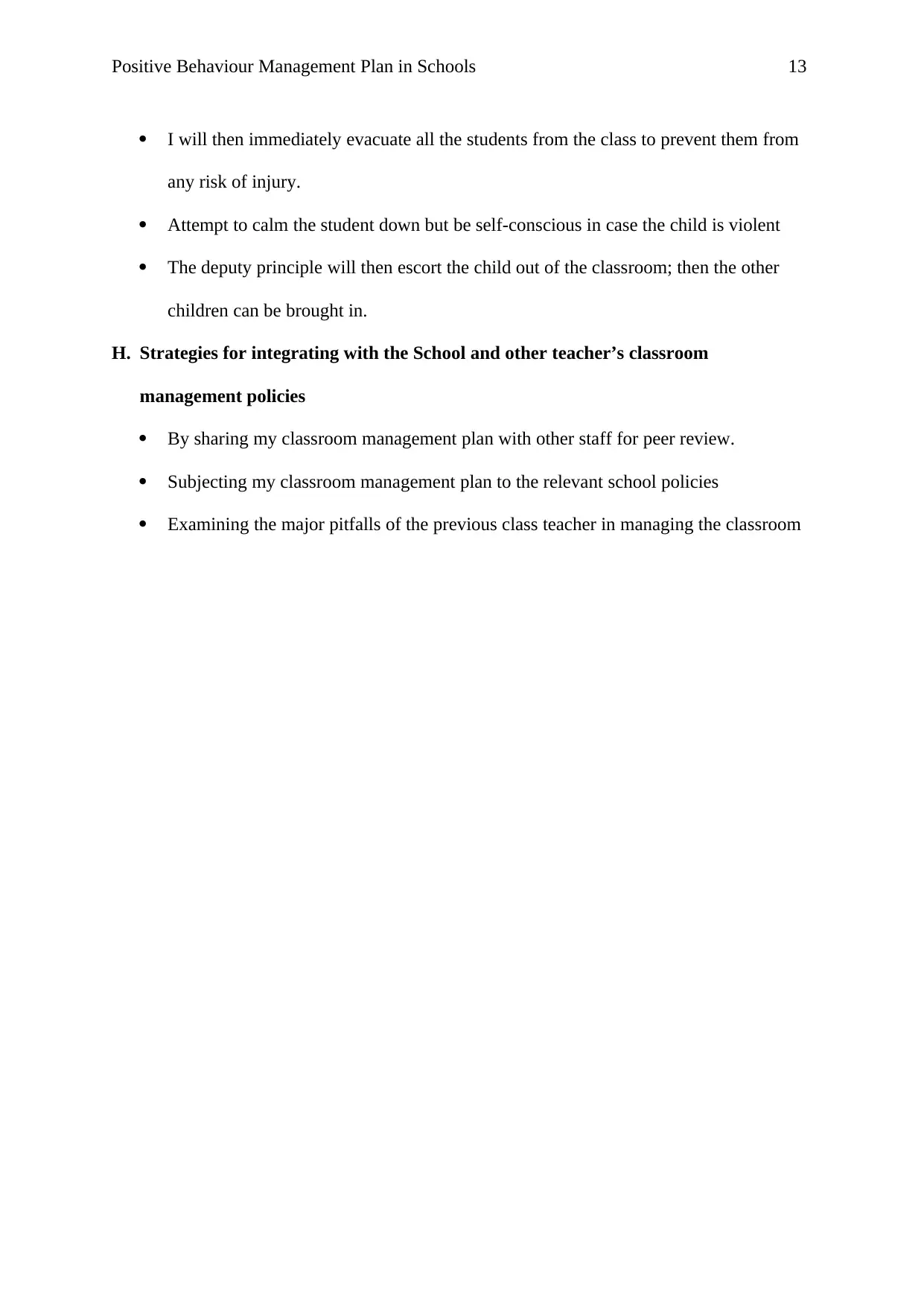
Positive Behaviour Management Plan in Schools 13
I will then immediately evacuate all the students from the class to prevent them from
any risk of injury.
Attempt to calm the student down but be self-conscious in case the child is violent
The deputy principle will then escort the child out of the classroom; then the other
children can be brought in.
H. Strategies for integrating with the School and other teacher’s classroom
management policies
By sharing my classroom management plan with other staff for peer review.
Subjecting my classroom management plan to the relevant school policies
Examining the major pitfalls of the previous class teacher in managing the classroom
I will then immediately evacuate all the students from the class to prevent them from
any risk of injury.
Attempt to calm the student down but be self-conscious in case the child is violent
The deputy principle will then escort the child out of the classroom; then the other
children can be brought in.
H. Strategies for integrating with the School and other teacher’s classroom
management policies
By sharing my classroom management plan with other staff for peer review.
Subjecting my classroom management plan to the relevant school policies
Examining the major pitfalls of the previous class teacher in managing the classroom
Paraphrase This Document
Need a fresh take? Get an instant paraphrase of this document with our AI Paraphraser
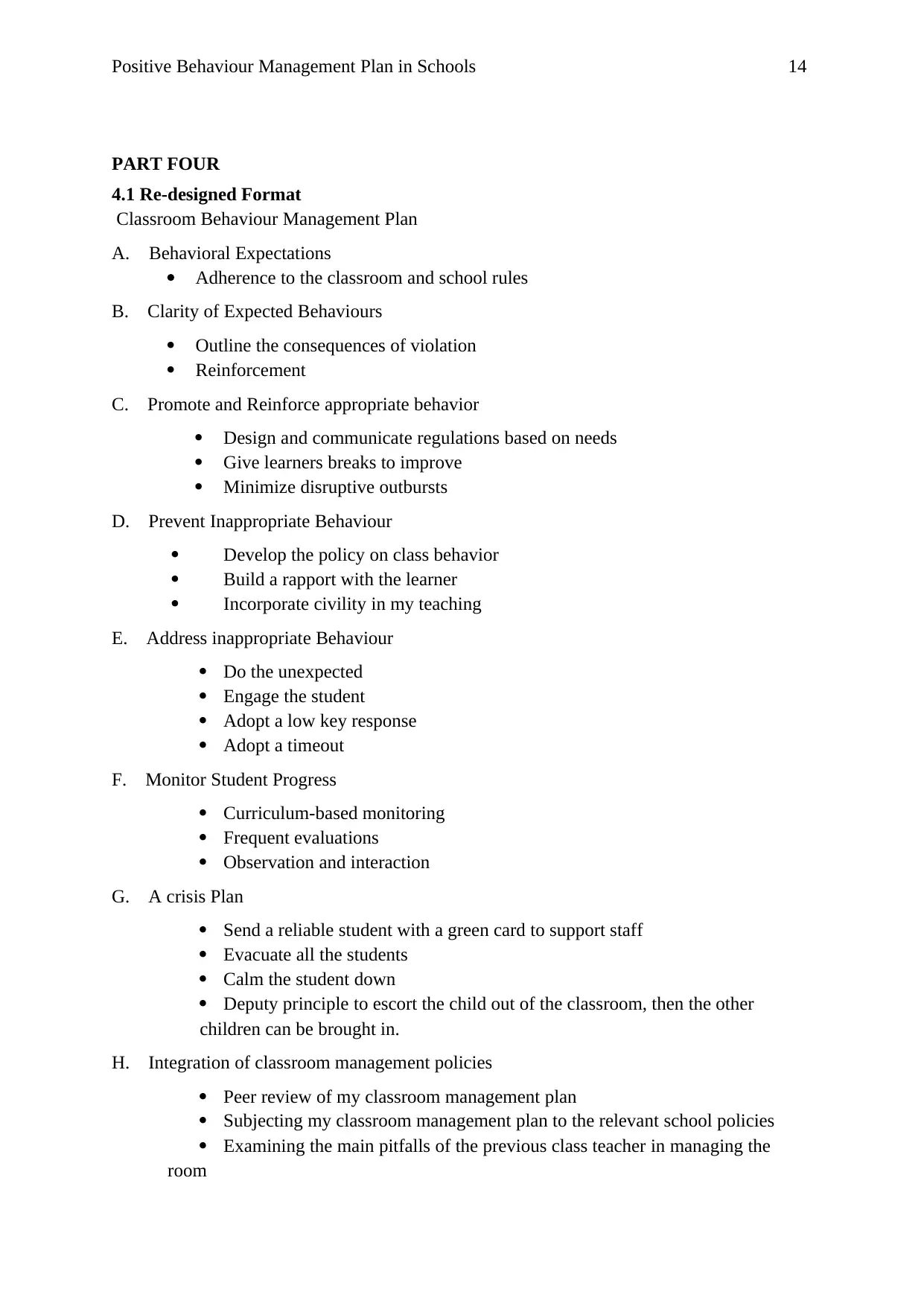
Positive Behaviour Management Plan in Schools 14
PART FOUR
4.1 Re-designed Format
Classroom Behaviour Management Plan
A. Behavioral Expectations
Adherence to the classroom and school rules
B. Clarity of Expected Behaviours
Outline the consequences of violation
Reinforcement
C. Promote and Reinforce appropriate behavior
Design and communicate regulations based on needs
Give learners breaks to improve
Minimize disruptive outbursts
D. Prevent Inappropriate Behaviour
Develop the policy on class behavior
Build a rapport with the learner
Incorporate civility in my teaching
E. Address inappropriate Behaviour
Do the unexpected
Engage the student
Adopt a low key response
Adopt a timeout
F. Monitor Student Progress
Curriculum-based monitoring
Frequent evaluations
Observation and interaction
G. A crisis Plan
Send a reliable student with a green card to support staff
Evacuate all the students
Calm the student down
Deputy principle to escort the child out of the classroom, then the other
children can be brought in.
H. Integration of classroom management policies
Peer review of my classroom management plan
Subjecting my classroom management plan to the relevant school policies
Examining the main pitfalls of the previous class teacher in managing the
room
PART FOUR
4.1 Re-designed Format
Classroom Behaviour Management Plan
A. Behavioral Expectations
Adherence to the classroom and school rules
B. Clarity of Expected Behaviours
Outline the consequences of violation
Reinforcement
C. Promote and Reinforce appropriate behavior
Design and communicate regulations based on needs
Give learners breaks to improve
Minimize disruptive outbursts
D. Prevent Inappropriate Behaviour
Develop the policy on class behavior
Build a rapport with the learner
Incorporate civility in my teaching
E. Address inappropriate Behaviour
Do the unexpected
Engage the student
Adopt a low key response
Adopt a timeout
F. Monitor Student Progress
Curriculum-based monitoring
Frequent evaluations
Observation and interaction
G. A crisis Plan
Send a reliable student with a green card to support staff
Evacuate all the students
Calm the student down
Deputy principle to escort the child out of the classroom, then the other
children can be brought in.
H. Integration of classroom management policies
Peer review of my classroom management plan
Subjecting my classroom management plan to the relevant school policies
Examining the main pitfalls of the previous class teacher in managing the
room
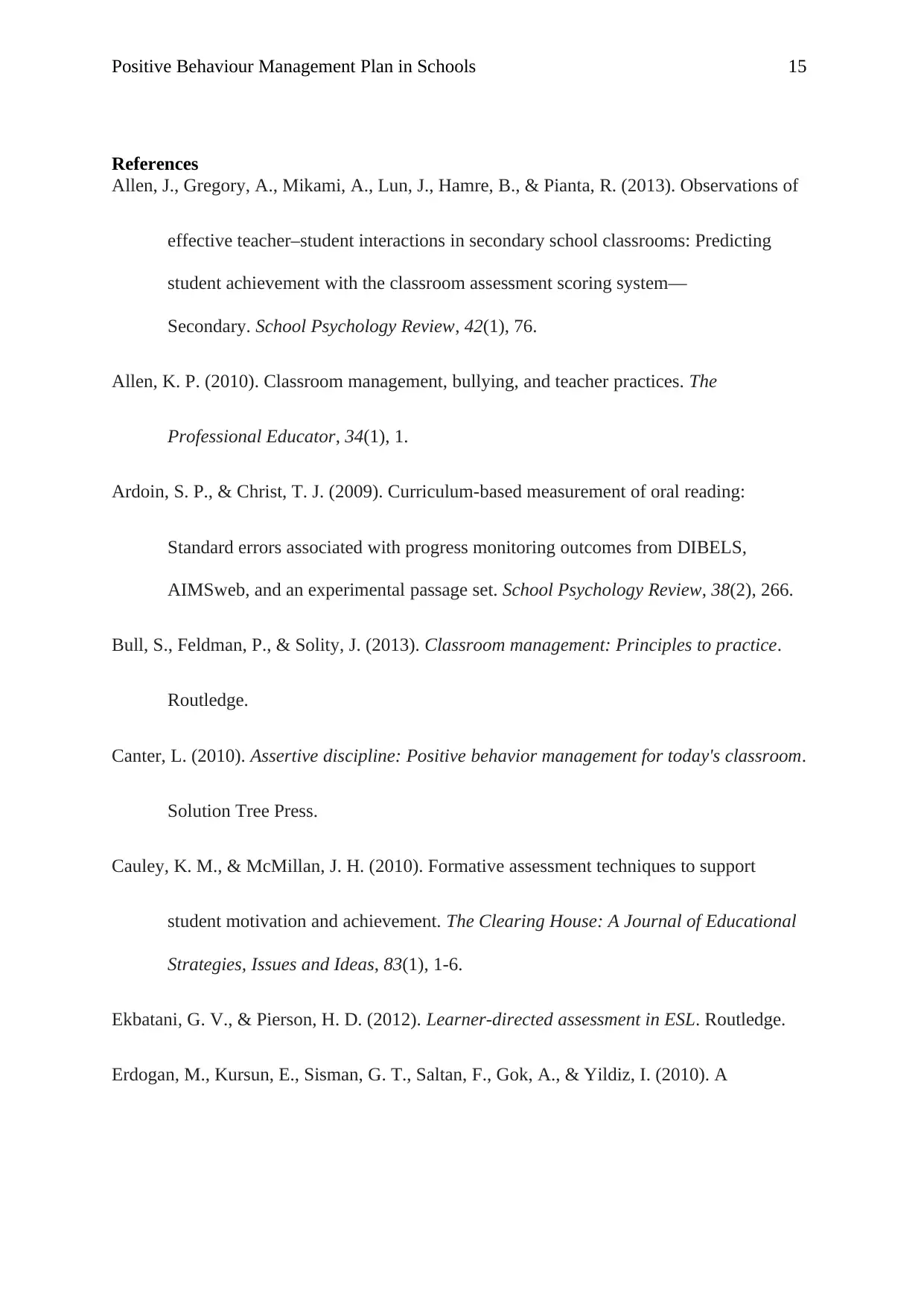
Positive Behaviour Management Plan in Schools 15
References
Allen, J., Gregory, A., Mikami, A., Lun, J., Hamre, B., & Pianta, R. (2013). Observations of
effective teacher–student interactions in secondary school classrooms: Predicting
student achievement with the classroom assessment scoring system—
Secondary. School Psychology Review, 42(1), 76.
Allen, K. P. (2010). Classroom management, bullying, and teacher practices. The
Professional Educator, 34(1), 1.
Ardoin, S. P., & Christ, T. J. (2009). Curriculum-based measurement of oral reading:
Standard errors associated with progress monitoring outcomes from DIBELS,
AIMSweb, and an experimental passage set. School Psychology Review, 38(2), 266.
Bull, S., Feldman, P., & Solity, J. (2013). Classroom management: Principles to practice.
Routledge.
Canter, L. (2010). Assertive discipline: Positive behavior management for today's classroom.
Solution Tree Press.
Cauley, K. M., & McMillan, J. H. (2010). Formative assessment techniques to support
student motivation and achievement. The Clearing House: A Journal of Educational
Strategies, Issues and Ideas, 83(1), 1-6.
Ekbatani, G. V., & Pierson, H. D. (2012). Learner-directed assessment in ESL. Routledge.
Erdogan, M., Kursun, E., Sisman, G. T., Saltan, F., Gok, A., & Yildiz, I. (2010). A
References
Allen, J., Gregory, A., Mikami, A., Lun, J., Hamre, B., & Pianta, R. (2013). Observations of
effective teacher–student interactions in secondary school classrooms: Predicting
student achievement with the classroom assessment scoring system—
Secondary. School Psychology Review, 42(1), 76.
Allen, K. P. (2010). Classroom management, bullying, and teacher practices. The
Professional Educator, 34(1), 1.
Ardoin, S. P., & Christ, T. J. (2009). Curriculum-based measurement of oral reading:
Standard errors associated with progress monitoring outcomes from DIBELS,
AIMSweb, and an experimental passage set. School Psychology Review, 38(2), 266.
Bull, S., Feldman, P., & Solity, J. (2013). Classroom management: Principles to practice.
Routledge.
Canter, L. (2010). Assertive discipline: Positive behavior management for today's classroom.
Solution Tree Press.
Cauley, K. M., & McMillan, J. H. (2010). Formative assessment techniques to support
student motivation and achievement. The Clearing House: A Journal of Educational
Strategies, Issues and Ideas, 83(1), 1-6.
Ekbatani, G. V., & Pierson, H. D. (2012). Learner-directed assessment in ESL. Routledge.
Erdogan, M., Kursun, E., Sisman, G. T., Saltan, F., Gok, A., & Yildiz, I. (2010). A
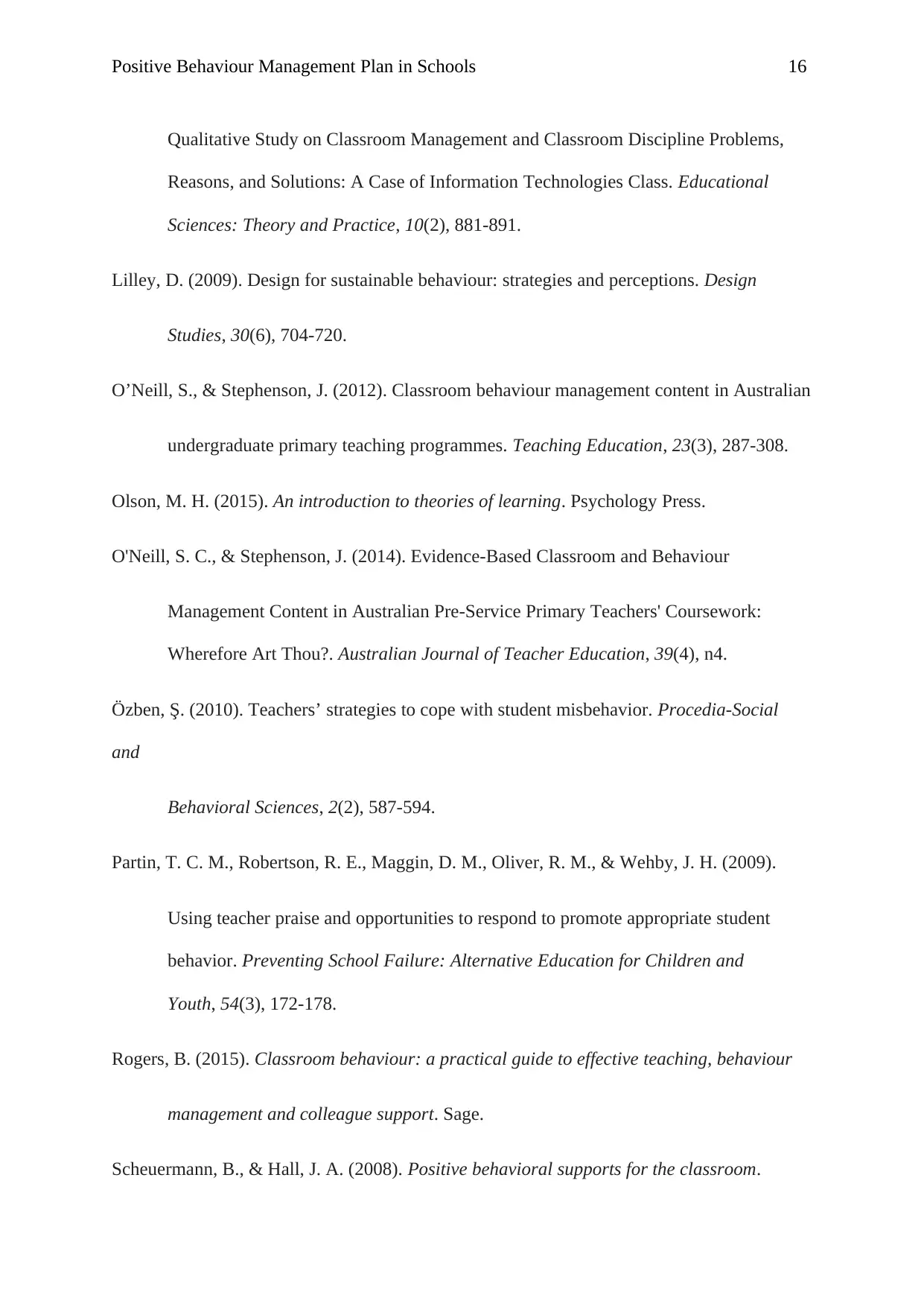
Positive Behaviour Management Plan in Schools 16
Qualitative Study on Classroom Management and Classroom Discipline Problems,
Reasons, and Solutions: A Case of Information Technologies Class. Educational
Sciences: Theory and Practice, 10(2), 881-891.
Lilley, D. (2009). Design for sustainable behaviour: strategies and perceptions. Design
Studies, 30(6), 704-720.
O’Neill, S., & Stephenson, J. (2012). Classroom behaviour management content in Australian
undergraduate primary teaching programmes. Teaching Education, 23(3), 287-308.
Olson, M. H. (2015). An introduction to theories of learning. Psychology Press.
O'Neill, S. C., & Stephenson, J. (2014). Evidence-Based Classroom and Behaviour
Management Content in Australian Pre-Service Primary Teachers' Coursework:
Wherefore Art Thou?. Australian Journal of Teacher Education, 39(4), n4.
Özben, Ş. (2010). Teachers’ strategies to cope with student misbehavior. Procedia-Social
and
Behavioral Sciences, 2(2), 587-594.
Partin, T. C. M., Robertson, R. E., Maggin, D. M., Oliver, R. M., & Wehby, J. H. (2009).
Using teacher praise and opportunities to respond to promote appropriate student
behavior. Preventing School Failure: Alternative Education for Children and
Youth, 54(3), 172-178.
Rogers, B. (2015). Classroom behaviour: a practical guide to effective teaching, behaviour
management and colleague support. Sage.
Scheuermann, B., & Hall, J. A. (2008). Positive behavioral supports for the classroom.
Qualitative Study on Classroom Management and Classroom Discipline Problems,
Reasons, and Solutions: A Case of Information Technologies Class. Educational
Sciences: Theory and Practice, 10(2), 881-891.
Lilley, D. (2009). Design for sustainable behaviour: strategies and perceptions. Design
Studies, 30(6), 704-720.
O’Neill, S., & Stephenson, J. (2012). Classroom behaviour management content in Australian
undergraduate primary teaching programmes. Teaching Education, 23(3), 287-308.
Olson, M. H. (2015). An introduction to theories of learning. Psychology Press.
O'Neill, S. C., & Stephenson, J. (2014). Evidence-Based Classroom and Behaviour
Management Content in Australian Pre-Service Primary Teachers' Coursework:
Wherefore Art Thou?. Australian Journal of Teacher Education, 39(4), n4.
Özben, Ş. (2010). Teachers’ strategies to cope with student misbehavior. Procedia-Social
and
Behavioral Sciences, 2(2), 587-594.
Partin, T. C. M., Robertson, R. E., Maggin, D. M., Oliver, R. M., & Wehby, J. H. (2009).
Using teacher praise and opportunities to respond to promote appropriate student
behavior. Preventing School Failure: Alternative Education for Children and
Youth, 54(3), 172-178.
Rogers, B. (2015). Classroom behaviour: a practical guide to effective teaching, behaviour
management and colleague support. Sage.
Scheuermann, B., & Hall, J. A. (2008). Positive behavioral supports for the classroom.
Secure Best Marks with AI Grader
Need help grading? Try our AI Grader for instant feedback on your assignments.
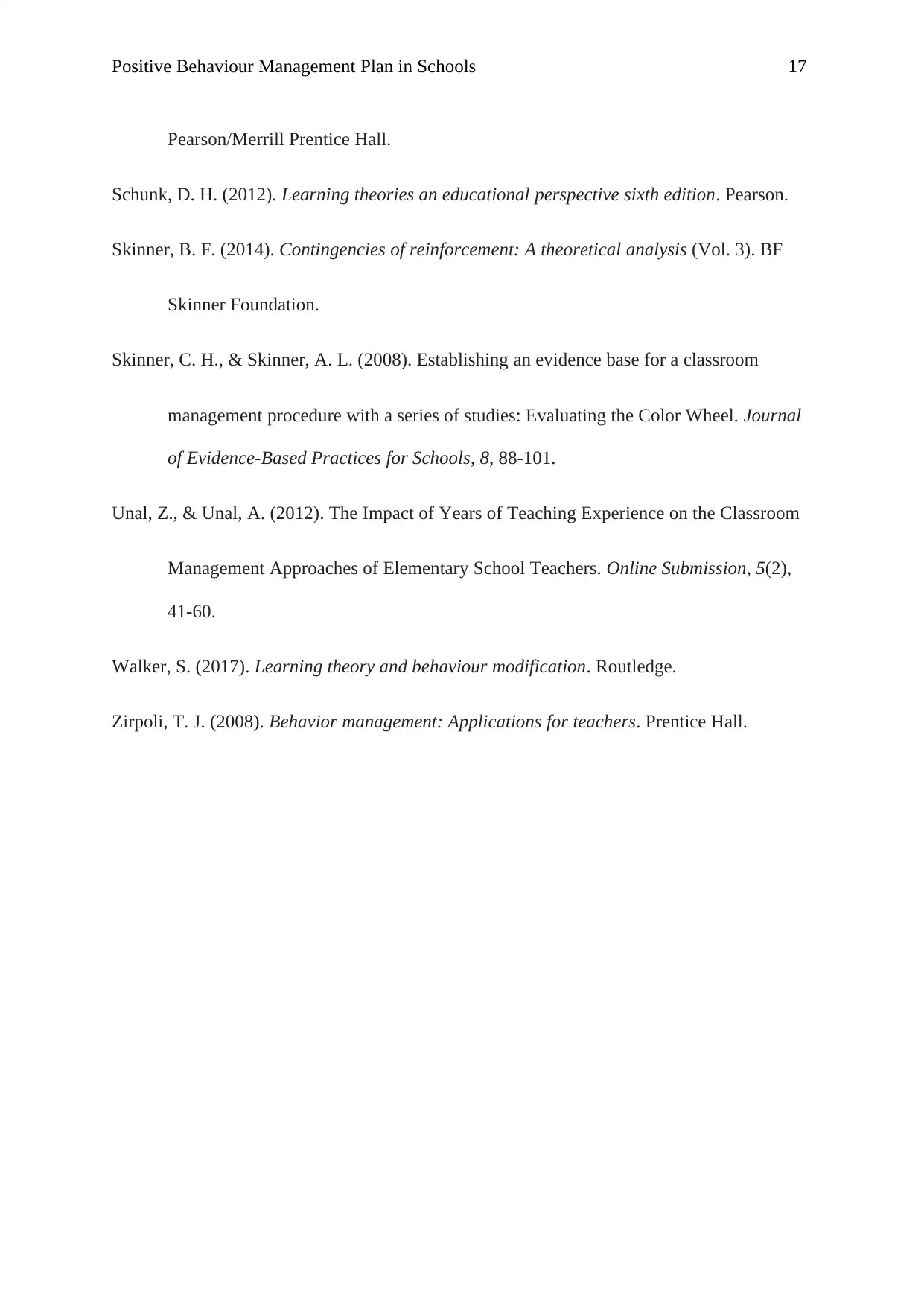
Positive Behaviour Management Plan in Schools 17
Pearson/Merrill Prentice Hall.
Schunk, D. H. (2012). Learning theories an educational perspective sixth edition. Pearson.
Skinner, B. F. (2014). Contingencies of reinforcement: A theoretical analysis (Vol. 3). BF
Skinner Foundation.
Skinner, C. H., & Skinner, A. L. (2008). Establishing an evidence base for a classroom
management procedure with a series of studies: Evaluating the Color Wheel. Journal
of Evidence-Based Practices for Schools, 8, 88-101.
Unal, Z., & Unal, A. (2012). The Impact of Years of Teaching Experience on the Classroom
Management Approaches of Elementary School Teachers. Online Submission, 5(2),
41-60.
Walker, S. (2017). Learning theory and behaviour modification. Routledge.
Zirpoli, T. J. (2008). Behavior management: Applications for teachers. Prentice Hall.
Pearson/Merrill Prentice Hall.
Schunk, D. H. (2012). Learning theories an educational perspective sixth edition. Pearson.
Skinner, B. F. (2014). Contingencies of reinforcement: A theoretical analysis (Vol. 3). BF
Skinner Foundation.
Skinner, C. H., & Skinner, A. L. (2008). Establishing an evidence base for a classroom
management procedure with a series of studies: Evaluating the Color Wheel. Journal
of Evidence-Based Practices for Schools, 8, 88-101.
Unal, Z., & Unal, A. (2012). The Impact of Years of Teaching Experience on the Classroom
Management Approaches of Elementary School Teachers. Online Submission, 5(2),
41-60.
Walker, S. (2017). Learning theory and behaviour modification. Routledge.
Zirpoli, T. J. (2008). Behavior management: Applications for teachers. Prentice Hall.
1 out of 17
Related Documents
Your All-in-One AI-Powered Toolkit for Academic Success.
+13062052269
info@desklib.com
Available 24*7 on WhatsApp / Email
![[object Object]](/_next/static/media/star-bottom.7253800d.svg)
Unlock your academic potential
© 2024 | Zucol Services PVT LTD | All rights reserved.





